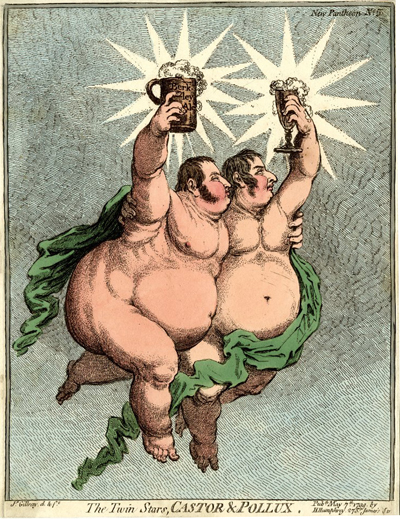The Twin Stars. . .
This is the fifth of six prints from the New Pantheon of Democratic Mythology portraying Whig statesmen as figures from popular mythology; in this case, George Barclay (1759-1819) and Charles Sturt (1763-1812), Whig MPs, as Castor and Pollux. For more about the series in general, see my commentary on the frontispiece to the New Pantheon of Democratic Mythology.

© Trustees of the British Museum
In Greek and Roman tales, Castor and Pollux were twin brothers, sons of Leda, impregnated by Zeus in the form of a swan. Accounts of their activities vary, but in the best known tradition, Castor and Pollux eventually become the brilliant constellation, Gemini, or the twins.
In Gillray's hands, the twin stars are portrayed as grotesque putti in the manner of Boucher or Rubens, thus satirizing the high art predilection for portraying classical gods in the nude and at the same time making fun of the practice of some portrait artists of elevating their sitters by posing them as classical figures.
Barclay and Sturt were indeed staunch Foxites and members of the opposition, twins in being elected in roughly the same year from Bridport. Gilray shows them raising tankards of beer, but it was the unrelated Charles Barclay (1780-1855), not George, who owned a brewery.
From the account of Charles Sturt in The History of Parliament, it is easy enough to see why he would have been regarded as a star in the democratic pantheon.
A member of the Whig Club since 1786, [Sturt] remained in opposition and voted steadily with the Foxites. He was in the habit of entertaining Fox and his friends at his maritime residence of Brownsea Castle. He was listed a supporter of repeal of the Test Act in Scotland in 1791. He consorted with the Friends of the People and the Friends of Freedom and assured his constituents that he was "a Friend to Peace", which his votes confirmed. He was also a firm friend of the Prince of Wales and on 1 June 1795 deplored the raising of the question of the Prince's debts in the House, acting as teller for the amendment....
On 23 Nov. 1795 Sturt presented to the House a petition signed by 12,000 supporters of the London Corresponding Society against the sedition bills, having attended the Palace Yard meeting against them the week before. "Although not in the habit of public speaking," he defended the Society, particularly in their espousal of parliamentary reform. He defended a radical pamphlet (King killing no murder) and attacked a Tory one (John Reeves's Thoughts on English Government), reading a passage from it which he claimed was a libel on the House.
George Barclay was both less active and less distinguished.
Sources and Reading
- Commentary from the British Museum on The Twin Stars. . .
- Draper Hill, Mr. Gillray The Caricaturist, 1965 p. 81n.
- Draper Hill, Fashionable Contrasts, 1966, #70
- Draper Hill, The Satirical Etchings of James Gillray, 1976, #63
- "Castor and Pollux," Wikipedia
- "George Barclay," History of Parliament
- "Charles Sturt," History of Parliament
- Thomas Wright and R.H. Evans, Historical and Descriptive Account of the Caricatures of James Gillray #235
- Thomas Wright and Joseph Grego, The Works of James Gillray, the Caricaturist; With the History of His Life and Times, p. 259
Comments & Corrections
NOTE: Comments and/or corrections are always appreciated. To make that easier, I have included a form below that you can use. I promise never to share any of the info provided without your express permission.